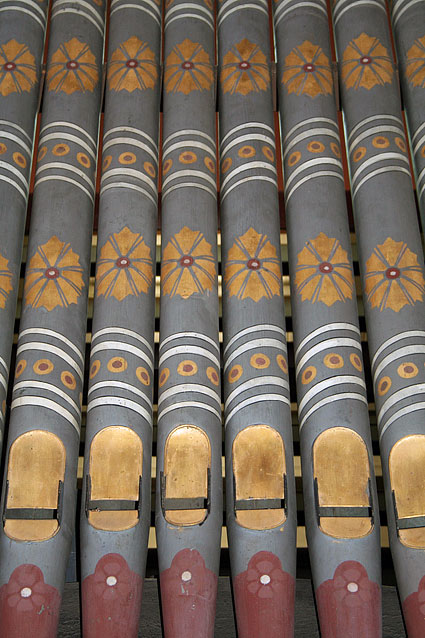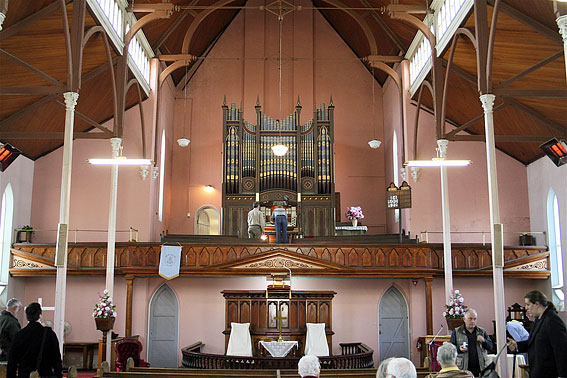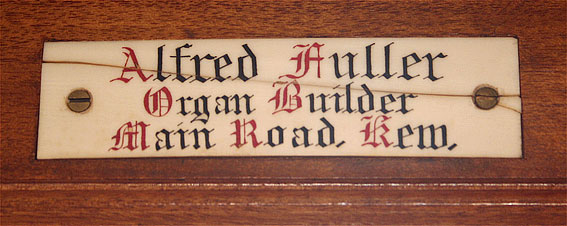Uniting Church
Long Gully, Bendigo
B 1882 Alfred Fuller;
reb & enl 1904 BC Pentreath (new soundboards & additional stops).
Restored 1982 S. J. Laurie.
2 manuals, 15 speaking stops, 3 couplers, tracker action
Gt: 8.8.8.4.4.2-2/3.2. Sw: 8.8 divided.8.4.4.2.8. Ped: 16.


from OHTA CONFERENCE BOOK AUGUST 1985
The former Methodist Church and Sunday Schools Long Gully, were erected in two stages: the School in 1865 (contractor, Mr Patterson) and the Church in 1877 (contractors, Manley and Harris, and Mr Marks). The architects for both stages were Vahland & Getzschmann. The complex is dominated by the brick church which comprises an aisled nave. The School is a simply conceived buttressed hall at the rear of the church. The two are united by a small arcade,
The Church is the more notable element of this complex and is an important and possibly unique example of the gothic revival in Victoria, It is articulated in a mannerist style and incorporates a series of features which are made nonsense by the great bulk of the structure and its internal space. These features include the fine pinnacles and bellcote, the row of tiny clerestory windows, the slender nave columns and the unusual tiny porches on the west facade. The zebra polychrome window decoration is also important.
No significant alterations have been made to the buildings since they were constructed and they appear to be in a sound structural condition.
Of State significance. [1]
The organ was built c.1892 by Alfred Fuller, of Kew, but no contemporary description of its opening has yet been located. Its casework was virtually identical with the Fuller organ at the Methodist Church., New Street, Brighton, installed c.1893. [2] Originally built with two manuals and 11 speaking stops, [3] the instrument was rebuilt, enlarged and modified in 1904 by a local lorganbuilder B.C. Pentreath, who was better known as an engineer in Bendigo. [4] At this time, the soundboards were largely replaced, retaining the Fuller pallets, it is believed, and much of the original action; a number of ranks were also added. [5] Karl Uhd, carpenter, of Long Gully, assisted in this work. [6] It is possible that the Fuller organ, as originally built, was damaged by the high level of fallout from the adjacent sandheaps and mining batteries. [7] The reservoir was moved to a site adjacent to the organ at some stage and the organ blown by a hydraulic engine, by Hugh Swanton, London, which still survives in a recess at ground level. [8]
The soundboards and pipework of the organ were restored in 1982 by Laurie Pipe Organs. The tables, sliders, upperboards and rackboards had to be replaced, and the pipework was mended, cleaned and regulated. It was not possible to restore the casework at this time, but the console doors were repainted and regilded as an initial phase in this work. [9].
This is a delightful instrument well-sited in an acoustically excellent building. Its painted case is typical of Alfred Fuller's work,
| GREAT Open diapason Clarabel Stop diapason Principal Flute Twelfth Fifteenth SWELL Open diapason Gedacht TC Viol de gamba TC Gemshorn Swabe flute Piccolo Oboe tremolo PEDAL Bourdon |
8 8 8 4 4 2-2/3 2 8 8 8 4 4 2 8 16 |
compass: 56/30
3 composition pedals to great
2 composition pedals to swell
trigger swell lever
mechanical action [10]
[1] National Trust of Australia (Victoria) building citation.
[2] Notes, John Maidment
[3] E.N. Matthews. Colonial organs and organbuilders. Carlton: Melbourne University Press, 1969, p-.163,*
[4] Inscription on organ, noted by Steve Laurie; Pers.comm. R.A. Anderson to John Maidment 1982
[5] Pers.comm. Steve Laurie to John Maidment, June 1982
[6] Inscription on organ, noted by Steve Laurie
[7] Pers.comm. R.A. Anderson to John Maidment, July 1985
[8] Notes., John Maidment
[9] Pers.comm. Steve Laurie to John Maidment, June 1982
[10] Spec. noted John Maidment, March 1966
 |
 |
|
 |
 |
|
 |
 |
|

|
||

Water engine |
||

|
||

|
||

|
||
Photos: Trevor Bunning (Oct. 2008)
Last two photos: MQ (Oct. 2008)
Old photo: SC